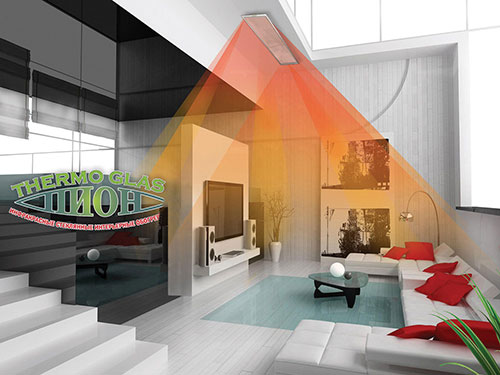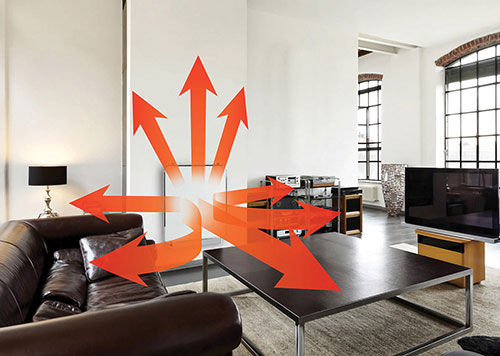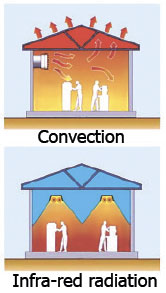
Heating and healing
Infra-red saunas are well-known, although many of us may remain suspicious regarding their ‘safety’, linking them to the potentially dangerous UVA and UVB rays of the sun. Of course, sunlight is also a source of life. An online search reveals that the infra-red spectrum has a range of ‘healing’ waves (from 7 to 14 micrometers). The human body receives these comfortably, as something ‘native’, absorbing the energy to positive effect. In fact, such infra-red light enhances our cell activity and encourages us to reduce water retention. In addition, our immunoglobulin levels rise, as do levels of enzymes and oestrogen. A whole host of positive bio-chemical reactions occur throughout the body.
Artificial infra-red light sources can be charged in an ordinary socket but even health professionals sometimes fail to realise that this can not only warm but heal. In the 1930s, French surgeons discovered that wounds repair quicker, and immunity is enhanced, allowing the body to fight infection better, if patients spend time under infra-red light. At that time, there were attempts to install special stoves in operating rooms but this proved dangerous, requiring many precautions, since stoves needed to be heated to at least 500 degrees to produce a healing effect.
It can be useful to view old ideas from a new angle, via the prism of modern technologies and materials. Times change and, at present, infra-red emitters produce the same range at under 140 degrees. They can be installed on the ceiling — like ordinary lamps — although special schemes are needed (depending on room features). An inner computer can choose an optimal mode of work, creating an artificial sun to aid healing.
Doctor of Physico-Mathematical Sciences Valery Kolos explains that, in Soviet times, scientists experimented with economical heating systems, following an order from the defence industry. Of course, working with radioactive substances and electronics is far more challenging than usual plumbing, requiring training in how to maintain a stable temperature and minimal air convection. After much consideration, infra-red radiation was decided upon. Elderly people may remember the old spiral electro-reflectors which used to be popular, using ASLOTU technology (automated system of ray provision for technological conditions). The two technologies are absolutely different: like an old cart and a modern Mercedes (although both have four wheels). That promising idea failed to be developed in Soviet times, as the USSR collapsed and its defence industry cut its orders.
In 1997, BelIKO Scientific-Production Enterprise was established at the Academy of Sciences, to introduce ASLOTU — headed by Doctor of Physico-Mathematic Sciences Valery Kolos (in the photo). Among the leading engineers were Victor Parshin and Alexander Rodionov. Later, the enterprise was transformed into the Belarusian National Academy of Sciences’ Energy Institute. Mr. Kolos is its Deputy Director of Innovation Work while his colleague, Candidate of Technical Sciences Alexander Akhramovich, is Academic Secretary.
Electrical cable better than heat pipelines
Scientific developments proved useful in post-Soviet times, when state energy saving programmes came to the fore. Then, Belarusian specialists studied global experience, to discover that the USA and Western Europe prefer electrical cables over heat pipelines. Among those countries employing energy saving technologies were Austria, Sweden, France and Norway. In the latter, over 75 percent of buildings are heated by electricity. With this in mind, the conversion idea of ASLOTU received support in Belarus and specialists from our Academy of Sciences continued developing ‘a ray system’.
Initially, much hope was pinned on ASLOTU, which actually helped engineers and technologies at Minsk’s Vavilov Mechanical Plant create a microclimate rivalling the most advanced technologies in 1998. This was necessary to establish production of gas meters and other highly accurate devices. To sustain the required temperature, workers used to create an artificial ‘hothouse’ effect with cellophane above. ASLOTU exceeded expectations, saving around $400,000 annually. Seminars were held to train specialists from other enterprises and, as a result, over two dozen ASLOTU systems were installed at Belarus’ leading plants, including Atlant, Integral and Horizont. Much profit was generated but, some time later, the process slowed down…

His Majesty Designer
It’s always a challenge to achieve wide application of an innovation, since it must be proven that the effects are large enough in scale. The necessary certificates and specialists’ reviews were obtained and ASLOTU was then supported by the Council of Ministers, the State Committee on Energy Efficiency and the Health Ministry. However, old ideas need to be put aside before anything new can come to our life; change does not always come easy. Some ASLOTU systems installed at Minsk medical establishments were dismantled and stored. An investigation was launched and it turned out that designers were unaware of the important innovation and preferred traditional heating systems.
An interesting poll was once conducted by the Health Ministry on ASLOTU, with the former Deputy Minister and Chief State Sanitary Doctor Mikhail Rimzha ready to study proposals from ASLOTU developers. He admitted that he hadn’t personally studied the healing possibilities of infra-red rays. Meanwhile, the Department of Investments, Capital Construction and Material-Technical Base noted that it endeavoured to take into consideration the recommendations of the Committee on Energy Efficiency when modernising medical establishments. However, investigation showed that officials responsible had little interest in issues of energy efficiency, relying exclusively on designers’ experience.
Clearly, designers can either slow down or facilitate technical progress! Even if my own house is being repaired, my opinion does not matter; the designer makes all the decisions. An official from the Health Ministry once tried to convince us that the system was failing to yield positive results. As a result, it was not approved by sanitary norms and regulations. However, following an order by the Council of Ministers, a document was passed envisaging the use of ASLOTU in medical and industrial establishments. As Mr. Kolos later stated, the Health Ministry reported to the Council of Ministers in April 2002. Sadly, much money and heat has been lost since then, and officials have changed positions. It appears that medical specialists have forgotten that artificial sun — created by infra-red rays — may not simply save energy but produce major healing effects on patients at hospitals and polyclinics and on maternity wards. It can reduce the incidence of pneumonia and the risk of infection following an operation.
A head doctor once attempted to explain his cautious attitude to ASLOTU, saying that each organ has its own radiation wavelength, and that nobody knows for sure how our lungs, hearts or brains would react to permanent infra-red rays. ASLOTU developers have their own arguments, saying that ‘walking, breathing fresh air and the warmth of the sun is useful for all’. With this in mind, it seems unreasonable to challenge truths with experimental data…
Interestingly, infra-red rays positively influence expectant mothers, allowing newborns to better adapt to their new life and for young mothers to recover well in their post-natal period. Patients recover more quickly when surrounded by ‘artificial sun’ — as noticed by doctors from Minsk’s 7th city hospital and the Belarusian Scientific-Research Institute of Traumatology and Orthopaedics (where ASLOTU was previously used and later stored during reconstruction of the building). The system is especially convenient in the colder seasons, to create ‘a surgical heat regime’. Computer software can ensure that operating rooms are warmed to a comfortable temperature for doctors and patients. Importantly, the system — operational at Minsk’s Emergency Aid Hospital — also has state hygienic registration. Guided by positive results, in March 2002, the Health Ministry allowed ‘installation of infra-red ASLOTU-type systems at industrial enterprises, health and recuperative sites, sports facilities and agricultural enterprises’.
However, a minor step remains: to obtain current from the Belarusian nuclear power station and shift to electric heating. It’s evident that specialists (and the public) must first be ready to accept a new energy reality. Those designing new buildings need to accept infra-red rays as ‘the heating of the future’. However, where a residential block already has heating pipes, builders will face a dilemma regarding which kind of heating to use.
Heating radiators vs infra-red radiation
 It’s interesting to study obstacles on the path to ASLOTU implementation, realising that it’s not easy to let past technologies go. It’s unreasonable to expect residential blocks and large enterprises to make immediate changes to electric heating once the Belarusian nuclear power station is launched. However, scientists such as Alexander Mikhalevich and Leonid Gerasimovich (experts in hermophysics and electric technologies) are sure that this process in inevitable.
It’s interesting to study obstacles on the path to ASLOTU implementation, realising that it’s not easy to let past technologies go. It’s unreasonable to expect residential blocks and large enterprises to make immediate changes to electric heating once the Belarusian nuclear power station is launched. However, scientists such as Alexander Mikhalevich and Leonid Gerasimovich (experts in hermophysics and electric technologies) are sure that this process in inevitable.
ASLOTU can be viewed as a test indicating the receptiveness of officials to new ideas and technologies. Some Minsk pensioners do not use mobile phones, which is their personal choice. Meanwhile, young people may not work in the same way as their counterparts generations ago: our economy is open and we face modern challenges. Before the nuclear power station launches, we may like to reconsider our views on heat supply. It’s quite possible that it will become more profitable to heat residential houses in Belarus with electricity, rather than combusting exported petroleum pitch and laying heating pipelines.
Lower electricity prices are a decisive argument for ASLOTU implementation. About five years ago, the State Committee on Energy Efficiency gave a press conference stressing that heating residential houses in Belarus with electricity was unprofitable. It asserted that the idea is economically unfeasible, ignoring the fact that the idea clearly works for Norway, for example. The system has many advantages and we simply need to look closer at them: all information can be found on the Energy Institute’s site. Hundreds of sites - such as warehouses for white goods and special machinery, and large public buildings — could benefit greatly, saving money and creating a healthy environment for those within.
Reasonable conservatism welcomed
It’s certainly possible to understand caution and healthy conservatism of those who must decide to implement new heating systems but progression is the natural order of life. It would seem wise for the Health Ministry and Education Ministry to offer seminars devoted to ASLOTU, allowing experts to share their views and enlighten those who harbour misunderstandings or ignorant assumptions (such as ‘infra-red rays produce radiation’). As the Energy Institute admits, such views have influenced the decision not to realise truly efficient projects in heating Minsk’s Palace of Children and Youth, and a green construction laboratory at a Minsk college. An attempt was made in autumn 2008, with huge funds allocated from the city budget. However, teachers were wary of the change: an anachronism in our 21st century enlightened age, when educated people should embrace ‘the new’.
While installation of the first systems was in full swing at Minsk hospitals, a newspaper reporter wrote: ‘In the future, around 650 medical establishments countrywide will be equipped with ASLOTU’. Once the Belarusian nuclear power station begins its work, this prospect looks more realistic. Being built in Grodno Region, 18km from Ostrovets, the first reactor should launch in 2018, with the second coming into operation by 2019. Clearly, the Health Ministry and the Architecture and Construction Ministry need to gather and regulate all ASLOTU related documentation — to take a firm decision on replacing obsolete heating systems with new efficient devices. Importantly, this should positively influence public health.
The idea isn’t new, having been proposed by Candidate of Technical Sciences Gennady Dmitriev, who formerly headed Rational Use of Fuel-and-Energy Resources in Minsk and now works at the National Academy of Sciences’ Energy Institute. He is well aware of the problem and believes preserving old heating systems is a major ‘loss-making’ mistake.
It’s always a challenge to implement change but this is not a reason for giving up. Think of the progress in TV set technology, radio, cameras, and television and music recordings: old fashioned vinyl records, cassettes, cathode-ray TVs and videotape recorders remain in the past. The same is true for ASLOTU: arguments seem illogical since its financial sense is already proven. It should pay for itself within three years. The Belarusian Optical-Mechanical Association (BelOMO) is already using infra-red radiators, as is the LEMT Scientific-Technical Centre, led by academician Alexey Shkadarevich. They are now trying to convince Belarus to save millions of Dollars annually on heating. The workshops of our major machine building enterprises have capacity to build the equipment, if only we can overcome our fear, conservatism and red-tape barriers.
The National Academy of Sciences has developed a new concept for the country’s energy security, which is undergoing adoption at the moment. Electronic technologies are the way forward and could consume a whole edition of this publication alone.
By Ivan Zhdanovich











